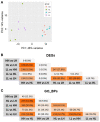The Impact of Varying Food Availability on Gene Expression in the Liver: Testing the Match-Mismatch Hypothesis
- PMID: 35859757
- PMCID: PMC9289739
- DOI: 10.3389/fnut.2022.910762
The Impact of Varying Food Availability on Gene Expression in the Liver: Testing the Match-Mismatch Hypothesis
Abstract
Background: During early phases of life, such as prenatal or early postnatal development and adolescence, an organism's phenotype can be shaped by the environmental conditions it experiences. According to the Match-Mismatch hypothesis (MMH), changes to this environment during later life stages can result in a mismatch between the individual's adaptations and the prevailing environmental conditions. Thus, negative consequences in welfare and health can occur. We aimed to test the MMH in the context of food availability, assuming adolescence as a sensitive period of adaptation.
Methods: We have previously reported a study of the physiological and behavioral effects of match and mismatch conditions of high (ad libitum) and low (90% of ad libitum intake) food availability from adolescence to early adulthood in female C57BL/6J mice (n = 62). Here, we performed RNA-sequencing of the livers of a subset of these animals (n = 16) to test the effects of match and mismatch feeding conditions on the liver transcriptome.
Results: In general, we found no effect of the match-mismatch situations. Contrarily, the amount of food available during early adulthood (low vs. high) drove the differences we observed in final body weight and gene expression in the liver, regardless of the amount of food available to the animals during adolescence. Many of the differentially expressed genes and the corresponding biological processes found to be overrepresented overlapped, implicating common changes in various domains. These included metabolism, homeostasis, cellular responses to diverse stimuli, transport of bile acids and other molecules, cell differentiation, major urinary proteins, and immunity and inflammation.
Conclusions: Our previous and present observations found no support for the MMH in the context of low vs high food availability from adolescence to early adulthood in female C57BL/6J mice. However, even small differences of approximately 10% in food availability during early adulthood resulted in physiological and molecular changes with potential beneficial implications for metabolic diseases.
Keywords: Match-Mismatch hypothesis; RNA-sequencing (RNA-seq); differential expression (DE) analysis; food availability changes; immunity and inflammation; liver transcriptome; metabolism.
Copyright © 2022 Feige-Diller, Herrera-Rivero, Witten, Stoll, Kaiser, Richter and Sachser.
Conflict of interest statement
The authors declare that the research was conducted in the absence of any commercial or financial relationships that could be construed as a potential conflict of interest.
Figures




Similar articles
-
The impact of varying food availability on health and welfare in mice: Testing the Match-Mismatch hypothesis.Physiol Behav. 2021 Jan 1;228:113193. doi: 10.1016/j.physbeh.2020.113193. Epub 2020 Oct 2. Physiol Behav. 2021. PMID: 33011232
-
Testing the cumulative stress and mismatch hypotheses of psychopathology in a rat model of early-life adversity.Physiol Behav. 2012 Jul 16;106(5):707-21. doi: 10.1016/j.physbeh.2012.01.015. Epub 2012 Jan 28. Physiol Behav. 2012. PMID: 22306534
-
Evidence supporting the match/mismatch hypothesis of psychiatric disorders.Eur Neuropsychopharmacol. 2014 Jun;24(6):907-18. doi: 10.1016/j.euroneuro.2014.02.002. Epub 2014 Feb 15. Eur Neuropsychopharmacol. 2014. PMID: 24589292
-
Safety and nutritional assessment of GM plants and derived food and feed: the role of animal feeding trials.Food Chem Toxicol. 2008 Mar;46 Suppl 1:S2-70. doi: 10.1016/j.fct.2008.02.008. Epub 2008 Feb 13. Food Chem Toxicol. 2008. PMID: 18328408 Review.
-
Growth, development and differentiation: a functional food science approach.Br J Nutr. 1998 Aug;80 Suppl 1:S5-45. doi: 10.1079/bjn19980104. Br J Nutr. 1998. PMID: 9849353 Review.
Cited by
-
Sex differences in body composition, voluntary wheel running activity, balance performance, and auditory function in CBA/CaJ mice across the lifespan.Hear Res. 2023 Feb;428:108684. doi: 10.1016/j.heares.2022.108684. Epub 2022 Dec 27. Hear Res. 2023. PMID: 36599258 Free PMC article.
-
Dietary restriction reveals sex-specific expression of the mTOR pathway genes in Japanese quails.Sci Rep. 2024 Apr 9;14(1):8314. doi: 10.1038/s41598-024-58487-9. Sci Rep. 2024. PMID: 38594358 Free PMC article.
References
LinkOut - more resources
Full Text Sources
Molecular Biology Databases
Research Materials
Miscellaneous

